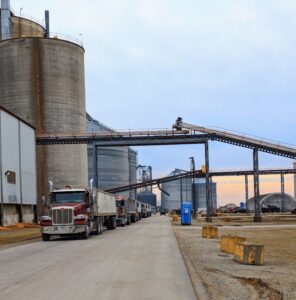SPRINGFIELD — The proposed carbon dioxide pipeline that would transport liquid CO2 captured from One Earth Energy’s ethanol plant in Gibson City to three injection wells in McLean County will require involvement from a number of landowners in both Ford and McLean counties, and company officials hope all will cooperate.
One Earth Sequestration LLC — a subsidiary of One Earth Energy, which operates a 150-million-gallon ethanol plant at 202 N. Jordan Drive in the Jordan Industrial Park on Gibson City’s west side — is providing financial compensation for those who do.
In the event there remain holdout landowners, though, the use of eminent domain could be a last-resort option to obtain the necessary right-of-way easements for One Earth Sequestration’s $19 million project, which would involve the construction of a 7.34-mile CO2 pipeline in western Ford and eastern McLean counties.
“OES intends to acquire the necessary land rights to construct and operate the OES Pipeline through good-faith voluntary negotiations with all landowners,” Steve Kelly, president and chief executive officer of One Earth Sequestration, said in testimony filed with the Illinois Commerce Commission in support of an application for a “certificate of authority” allowing the project to proceed and eminent domain to be exercised, if needed. “OES will extend offers to, and negotiate with, landowners for right-of-way easements in compliance with the provisions prescribed in the (Illinois Administrative Code). OES will resort to eminent domain only as a last resort after exhausting all attempts to reach an agreement voluntarily with each affected landowner.”

Trucks line up to deliver corn at One Earth Energy’s ethanol plant in Gibson City.
In his written testimony filed with the ICC in early December, Kelly said One Earth Sequestration is seeking a 40-foot permanent easement along the entirety of the pipeline, along with a 60-foot temporary easement during construction, for a total of 100 feet of right-of-way.
In addition, Kelly said, “areas of additional temporary workspace will be required at certain locations to accommodate crossings of roads, wetlands, waterbodies, existing utilities and other locations.”
“OES will also seek occasional private-access road agreements from landowners to facilitate construction access to locations where entry from the public right-of-way is not feasible,” Kelly said.
One Earth Sequestration will compensate landowners “at or above fair market values for the land interests acquired,” Kelly said, and “pay for anticipated and experienced damages, such as crop losses resulting from construction.”
Kelly said the involved landowners would be notified as legally required, and company officials would be having “multiple direct contacts with each landowner” to provide information, secure survey permissions, discuss and address concerns, gather relevant property-specific information, and present and negotiate offers.
“OES has drafted a form of easement agreement and has begun negotiations with affected landowners toward obtaining all easements and other necessary rights-of-way through a voluntary agreement,” Kelly said.
Kelly noted that company officials have “good working relationships with the local landowners and communities” and will “share information on safety and regulations, construction impacts and mitigation concerns, among other information.”
Property used in the project will be restored upon its completion, Kelly noted.
“All easement areas, except for any above-ground appurtenant facilities, will be restored to preconstruction conditions as much as is practicable,” Kelly said. “Temporary construction easements will revert to the landowner upon completion of installation and the OES Pipeline being placed in service. Valve locations will be fenced in and graveled, and the remainder of the permanent easement will revert to pre-construction conditions and use with the necessary restrictions expressed in the easement agreement to ensure safe and reliable operation of the OES Pipeline.”
Mark Ditsworth. vice president of technology and special projects for One Earth Sequestration, said in written testimony filed with the ICC that “to provide additional flexibility to respond to contingencies in development of the (project) route and project route width, OES may contact landowners within the corridor of 200 feet — 89 on either side of and along the proposed route in Ford and McLean counties — to obtain permission to conduct surveys on landowners’ properties.”
“The proposed centerline route and project route width may be refined based on additional planned survey activities and discussions with landowners, but the final route and project route width will be within the ‘notification corridor,” Ditsworth said.

